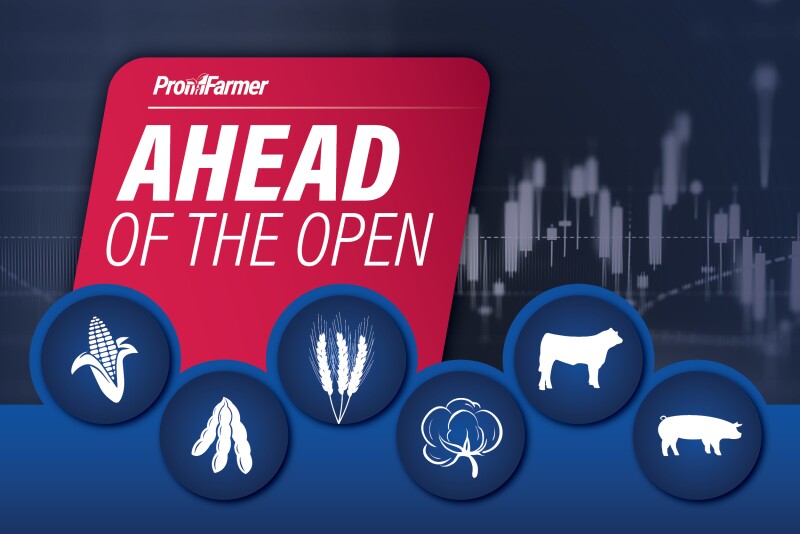GRAIN CALLS
Corn: 2 to 4 cents lower.
Soybeans: 6 to 8 cents higher.
Wheat: Winter wheat 2 to 4 cents lower; HRS 1 to 3 cents lower.
GENERAL COMMENTS: Soybeans saw relative strength overnight, supported by continued strength in soyoil. Corn and wheat favored the downside though traded within Tuesday’s range. Outside markets are mixed this morning as front-month crude oil futures are modestly higher while the U.S. dollar index is around 220 points higher.
House Republican leaders are scrambling to pass their multi-trillion-dollar reconciliation bill as soon as today – though the vote could slip until Thursday – racing against fierce opposition from both the hard-right and moderate wings of their conference. Speaker Mike Johnson (R-La.), Majority Leader Steve Scalise (R-La.), and Whip Tom Emmer (R-Minn.) are pressing ahead on a compressed timeline, but doubts are widespread about their ability to even clear a procedural rule for floor debate. Leadership is leaning on President Donald Trump’s influence to rally wavering members, but patience is running thin after repeated concessions failed to sway the bill’s critics. House GOP leadership can lose up to three Republican votes and still pass a reconciliation measure, assuming all Democrats vote against it and all members are present. The House of will meet today at 9 a.m. ET to debate and vote on the tax and spending bill, but the timeline for the vote is murky.
With the July 9 extension deadline for U.S. tariffs rapidly approaching, major American trading partners are facing heightened uncertainty over their economic prospects. Despite months of negotiations, dozens of country-specific trade deals remain unresolved, including high-stakes talks with the “key 18” nations highlighted by Treasury Secretary Scott Bessent. Negotiations with other major economies — including China, Japan, India and the European Union — are ongoing, each complicated by unique demands and domestic constraints. Trump and his officials have repeatedly warned that failure to reach deals by July 9 could trigger the snapback of tariffs to the steep levels set on April 2 — some reaching as high as 50%. Such a scenario risks significant economic and market disruption. Bessent has suggested some flexibility on the deadline, but only Trump can grant extensions. Even if agreements are reached, a baseline 10% tariff is expected to persist for most imports, with only substantial concessions potentially lowering rates further for select nations. Economists warn that if the bulk of tariffs are reimposed, the risk of a major supply shock — with attendant inflation, job losses, and strained global alliances — remains significant.
Farmer sentiment weakened sharply in June after two months of improvement, according to the Purdue University/CME Group Ag Economy Barometer. The overall barometer dropped 12 points to 146, driven mainly by a steeper decline in producers’ future outlook. The Index of Future Expectations fell 18 points to 146. The percentage of producers expecting declining exports also rose. The Current Conditions Index slipped 2 points to 144. Concerns about U.S. agricultural exports were a leading factor in the weaker long-term sentiment, with only 41% of farmers expecting export growth over the next five years — down from 52% in May. Farmers remain concerned that U.S. tariff policies could negatively impact their farms’ income, but fewer producers said they expected a negative or very negative impact on income than when tariff policies were the focus of attention in March and April. Click here for full report.
CORN: December corn futures favored the downside overnight. Support comes in at yesterday’s contract low of $4.16 1/2 and is reinforced by support at $4.10. Resistance stands at yesterday’s high of $4.25 then the 10-day moving average at $4.27 1/4.
SOYBEANS: November soybean futures led strength overnight. Overnight gains stopped just shy of resistance at $10.33 3/4, the 100-day moving average. That is reinforced by Monday’s high of $10.38 1/4. Support comes in at $10.27 then$10.16 1/2 on a reversal lower.
WHEAT: September SRW futures traded on either side of unchanged overnight. Initial resistance stands at $5.35 and is reinforced by resistance at $5.40, the 10-day moving average. Support comes in at the psychological $5.25 mark then yesterday’s low of $5.22 3/4.
LIVESTOCK CALLS
CATTLE: Lower.
HOGS: Choppy/lower.
CATTLE: Live cattle and feeders are expected to open lower in a continuation of recent selling pressure, though steep discounts to the cash market could limit losses after the open. Cash trade so far this week remains abysmal though will pick up the next couple days ahead of Friday’s holiday. Expectations call for weaker trade as futures have faced heavy long liquidation. Wholesale beef ended Tuesday mixed as Choice cutout inched 4 cents higher to $395.60, while Select sunk $4.04 to $380.06.
HOGS: Lean hog futures are expected to open with a mostly weaker tone as cash fundamentals appear to have topped seasonally, though technical support could limit losses after the open. The CME lean hog index is down 77 cents to $110.99 as of June 30, the second consecutive daily decline after an extended string of gains. Pork cutout has shown weakness recently as well, falling another $3.07 to $112.30 on Tuesday, led by weakness in butts, bellies and ribs. Cutout is now $10.81 below the June 24 peak.

